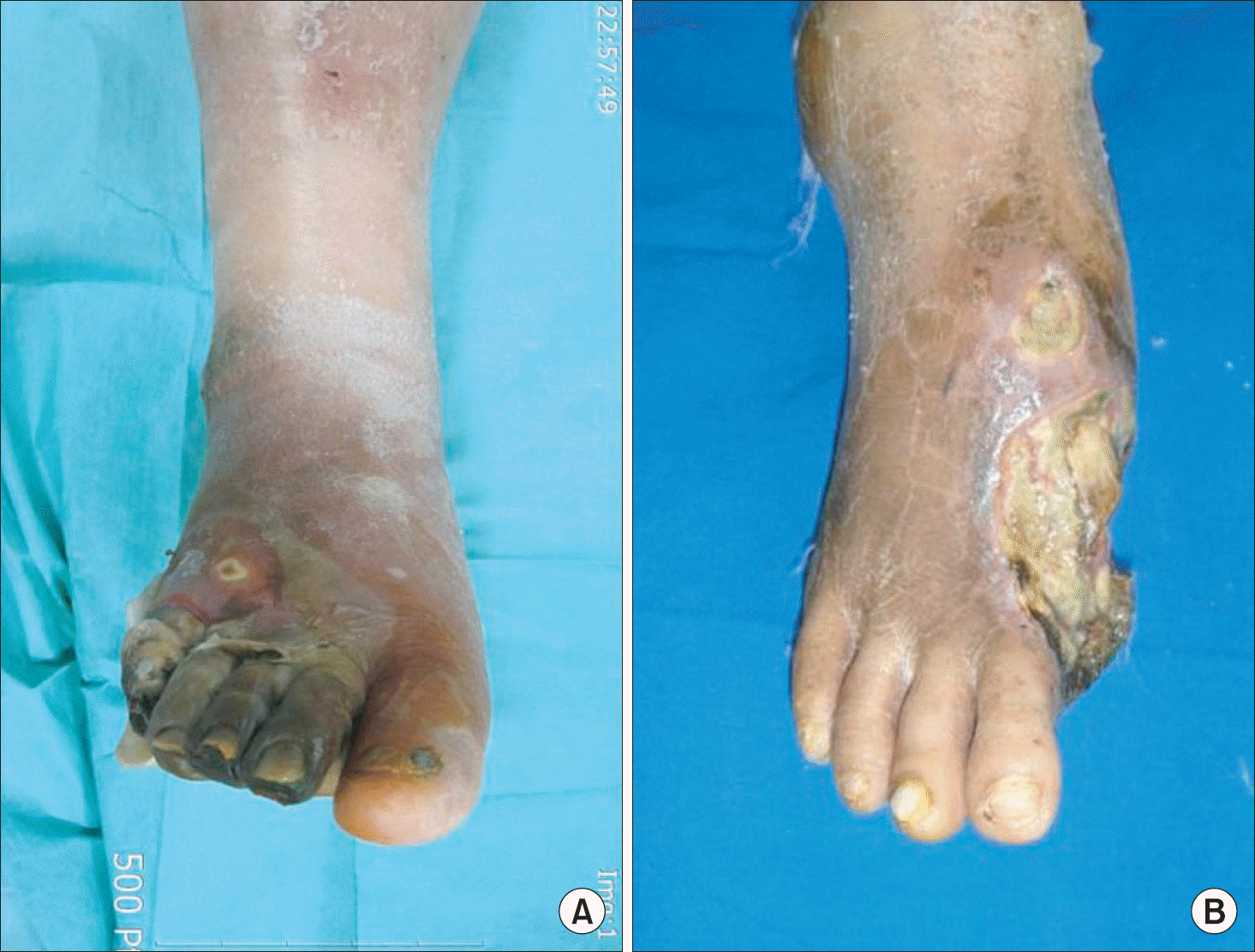Abstract
Amputation of diabetic foot ulcer and infection is a critical modality for saving a patient's life from life threatening infections or ischemic limbs. However, it can cause serious handicaps or complications, such as lifetime shortening and re-amputation of the other limb. The minimal amputation is the main goal of amputation in diabetic patients. However, insufficient amputation can have a harmful effect on patients. The decision of amputation is very difficult and should be made using multidisciplinary approaches. All aspects of the patient's situation, including vascular status, degree of infection, and medical conditions should be considered. The foot surgeon should keep in mind the notion that proper amputation can lead to a new life for diabetic foot patients.
References
1. Philbin TM, Berlet GC, Lee TH. Lower-extremity amputations in association with diabetes mellitus. Foot Ankle Clin. 2006; 11:791–804.

2. Resnick HE, Carter EA, Lindsay R, Henly SJ, Ness FK, Welty TK, et al. Relation of lower-extremity amputation to all-cause and cardiovascular disease mortality in American Indians: the Strong Heart Study. Diabetes Care. 2004; 27:1286–93.
3. Tentolouris N, Al-Sabbagh S, Walker MG, Boulton AJ, Jude EB. Mortality in diabetic and nondiabetic patients after amputations performed from 1990 to 1995: a 5-year follow-up study. Diabetes Care. 2004; 27:1598–604.
4. Bae JI, Won JH, Han SH, Lim SH, Hong YS, Kim JY, et al. Endovascular revascularization for patients with critical limb ischemia: impact on wound healing and long term clinical results in 189 limbs. Korean J Radiol. 2013; 14:430–8.

5. Gil J, Schiff AP, Pinzur MS. Cost comparison: limb salvage versus amputation in diabetic patients with charcot foot. Foot Ankle Int. 2013; 34:1097–9.
6. Sanders LJ, Robbins JM, Edmonds ME. History of the team approach to amputation prevention: pioneers and milestones. J Vasc Surg. 2010; 52(3 Suppl):3S–16S.

7. Fisher TK, Scimeca CL, Bharara M, Mills JL Sr, Armstrong DG. A stepwise approach for surgical management of diabetic foot infections. J Vasc Surg. 2010; 52(3 Suppl):72S–75S.

8. Waters RL, Perry J, Antonelli D, Hislop H. Energy cost of walking of amputees: the influence of level of amputation. J Bone Joint Surg Am. 1976; 58:42–6.
9. Pinzur MS. The metabolic cost of lower extremity amputation. Clin Podiatr Med Surg. 1997; 14:599–602.
10. Fletcher DD, Andrews KL, Hallett JW Jr, Butters MA, Rowland CM, Jacobsen SJ. Trends in rehabilitation after amputation for geriatric patients with vascular disease: implications for future health resource allocation. Arch Phys Med Rehabil. 2002; 83:1389–93.

11. Toursarkissian B, Shireman PK, Harrison A, D'Ayala M, School-field J, Sykes MT. Major lower-extremity amputation: contemporary experience in a single Veterans Affairs institution. Am Surg. 2002; 68:606–10.
12. Couch NP, David JK, Tilney NL, Crane C. Natural history of the leg amputee. Am J Surg. 1977; 133:469–73.

13. Steinberg FU, Sunwoo I, Roettger RF. Prosthetic rehabilitation of geriatric amputee patients: a follow-up study. Arch Phys Med Rehabil. 1985; 66:742–5.
14. Keagy BA, Schwartz JA, Kotb M, Burnham SJ, Johnson G Jr. Lower extremity amputation: the control series. J Vasc Surg. 1986; 4:321–6.

15. Robbs JV, Ray R. Clinical predictors of below-knee stump healing following amputation for ischaemia. S Afr J Surg. 1982; 20:305–10.
16. Canaud L, Alric P, Berthet JP, Marty-Ané C, Mercier G, Branchereau P. Infrainguinal cutting balloon angioplasty in de novo arterial lesions. J Vasc Surg. 2008; 48:1182–8.

17. LoGerfo FW, Coffman JD. Current concepts. Vascular and microvascular disease of the foot in diabetes. Implications for foot care. N Engl J Med. 1984; 311:1615–9.
18. Nam SC, Han SH, Lim SH, Hong YS, Won JH, Bae JI, et al. Factors affecting the validity of ankle-brachial index in the diagnosis of peripheral arterial obstructive disease. Angiology. 2010; 61:392–6.
19. Bonham PA, Cappuccio M, Hulsey T, Michel Y, Kelechi T, Jenkins C, et al. Are ankle and toe brachial indices (ABI-TBI) obtained by a pocket Doppler interchangeable with those obtained by standard laboratory equipment? J Wound Ostomy Continence Nurs. 2007; 34:35–44.

20. Carter SA, Tate RB. Value of toe pulse waves in addition to systolic pressures in the assessment of the severity of peripheral arterial disease and critical limb ischemia. J Vasc Surg. 1996; 24:258–65.

21. Bacharach JM, Rooke TW, Osmundson PJ, Gloviczki P. Predictive value of transcutaneous oxygen pressure and amputation success by use of supine and elevation measurements. J Vasc Surg. 1992; 15:558–63.

22. Ballard JL, Eke CC, Bunt TJ, Killeen JD. A prospective evaluation of transcutaneous oxygen measurements in the management of diabetic foot problems. J Vasc Surg. 1995; 22:485–90.

23. Bunt TJ, Holloway GA. TcPO2 as an accurate predictor of therapy in limb salvage. Ann Vasc Surg. 1996; 10:224–7.

24. Verta MJ Jr, Gross WS, van Bellen B, Yao JS, Bergan JJ. Forefoot perfusion pressure and minor amputation for gangrene. Surgery. 1976; 80:729–34.
25. Bone GE, Pomajzl MJ. Toe blood pressure by photoplethysmography: an index of healing in forefoot amputation. Surgery. 1981; 89:569–74.




 PDF
PDF ePub
ePub Citation
Citation Print
Print



 XML Download
XML Download